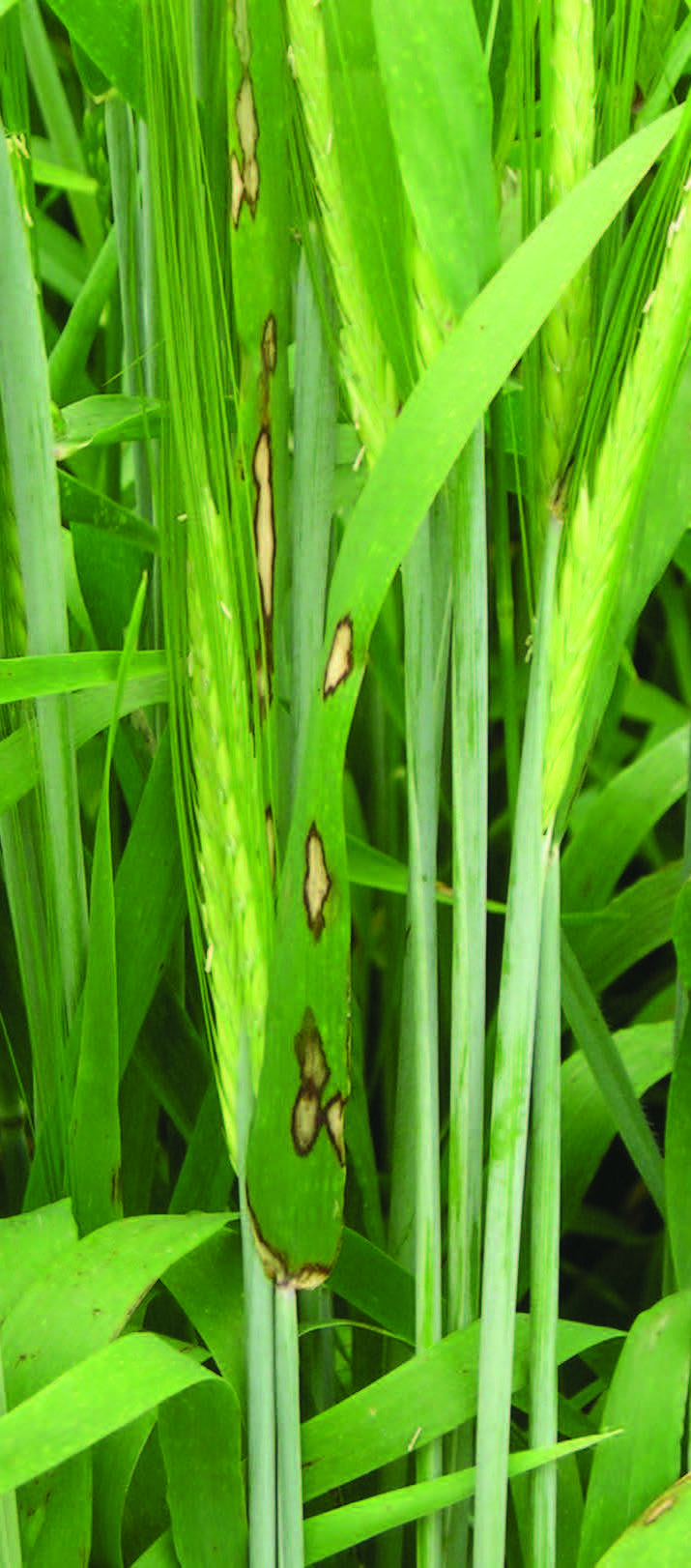- Home
- Knowledge library
- Control of rhynchosporium (leaf scald) in barley
Control of rhynchosporium (leaf scald) in barley
Capable of causing several infection cycles during the growing season, rhynchosporium is the most damaging disease of UK barley. However, varietal resistance, cultural measures and protectant fungicides can help suppress it.
How important is rhynchosporium in UK cereals?
Note: Also called leaf scald.
The disease affects barley, rye, triticale and a number of grasses, particularly ryegrasses. Specialised forms of the pathogen are, generally, restricted in their host range.
Rhynchosporium is the most damaging disease of UK barley. It can be very severe, particularly in the South-West, West and North of the UK, where conditions are generally wet. In winter barley, yield losses can exceed 1.5 t/ha and grain quality can be reduced.
The most serious effect on yield, in both winter and spring barley, results from attacks that develop between first node detectable and boot-swollen growth stages (GS 31–45). Visible levels of disease of 1–2% at GS 31-32 cause economic loss, if left untreated.
Rhynchosporium symptoms
Infection often occurs in the leaf axil.
Symptoms often first appear at the base of the leaf close to the stem.
Symptoms then spread to the rest of the leaf, leaf sheaths, ears and grain, particularly in wet conditions.
Initial symptoms often appear in random patches soon after sowing winter barley. Symptoms due to the seedborne phase of the disease do not appear until January/February, as the disease initially develops inside the leaves and roots without symptoms showing.
Typical, early symptoms are oval or irregular, pale green-grey, water-soaked lesions.
As the lesions age, they acquire a dark-brown margin (the centre remains pale green or turns pale brown).
Lesions often coalesce and form large areas, around which leaf yellowing is common. These can cause chlorosis and eventual death of the rest of the leaf.
In winter barley, symptom expression can be high during tillering in early spring.
In spring barley, it is rare to see symptoms until after tillering, except in very early sown crops.
In both crops, symptoms can build up rapidly after emergence of the flag leaf under favourable conditions.
Rhynchosporium can be confused with other abiotic spotting symptoms, but symptoms are always present on the lower leaves if they are present on the upper leaves, which can help diagnosis.
Rhynchosporium life cycle
- Rhynchosporium (Rhynchosporium commune) does not survive well in soil
- The seedborne phase is not fully understood
- The fungus survives for up to a year in crop debris
- Rain-splashed spores, from infected trash, stubble and volunteers, infect seedlings. Rain-splash continues to spread the disease up the canopy, infecting later-emerging leaves, ears and grains
- Long-distance spread of airborne spores by wind can also occur. This route of infection can be important in spring barley planted next to infected winter barley crops
- The disease is polycyclic. This means it is capable of causing several infection cycles during the growing season
- Cool, moist conditions favour the disease
- The disease cycle can repeat every 14 days
- The ideal temperature range is 18–20°C but temperatures over 20°C slow disease development
- There is also potentially a sexual stage of this disease
.JPG) AHDB
AHDB
Rhynchosporium risk factors
- Very early sowing
- Wet weather
- Tight rotations
- Infected trash, stubble, volunteers and seed
- Nearby infected crops
- Western and northern regions
- Reduced tillage, where trash remains on the soil surface
How to manage rhynchosporium in barley
- Grow varieties with a higher resistance rating. However, symptomless-infection and sporulation can also occur on both resistant and susceptible varieties
- Minimise barley trash, stubble and volunteers, and extend rotations
- Avoid saving seed from infected crops
- Manage nitrogen carefully, as a thick lush canopy creates the ideal microclimate for rhynchosporium
- Early-sown spring crops (December-February) and very early-sown winter crops will be at more risk
- Consider the use of protectant fungicides*
*Most fungicides have good protectant activity. However, few treatments have good eradicant activity in high-pressure situations. An effective azole, in mixture with a strobilurin or SDHI fungicide, is a good foundation for disease management. Spiroxamine, which is in the morpholine class, is also registered for use in barley.
Fungicide performance data
Our fungicide performance work provides high-quality, independent information on the relative efficacy of fungicides against key diseases in wheat, barley and oilseed rape.
Fungicide performance data is available for rhynchosporium
Fungicide programmes for barley
Further information
Cereal disease management homepage
Disease-risk map for rhynchosporium
.PNG) AHDB
AHDB
| High | Moderate | Low |


